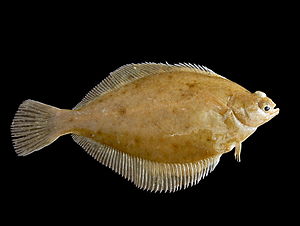Pleuronectoidei
| Pleuronectoidei | ||||||||||||
|---|---|---|---|---|---|---|---|---|---|---|---|---|

Dab ( Limanda limanda ) |
||||||||||||
| Systematics | ||||||||||||
|
||||||||||||
| Scientific name | ||||||||||||
| Pleuronectoidei | ||||||||||||
| Bleeker , 1859 |
The Pleuronectoidei are a subordination of the flatfish (Pleuronectiformes), to which, in contrast to the three types of the original, systematically basal hard- rayed flounder (Psettodoidei), all other flatfish species belong (over 670).
features
The pleuronectoidei no longer have hard rays in the unpaired fins (dorsal and anal fin). The dorsal fin extends to the head, in many species over the eyes. The palatine is edentulous, the basihyale, an element between the hyoid bones, is without a tooth plate. A basic phenoid is absent, the supramaxillary is absent or rudimentary (in the lyre-flatfish). The pleuronectoidei have 26 to 70 vertebrae, including 10 or more trunk vertebrae (vertebrae in front of the anus). The uroneuralia , small, paired rods in the caudal fin skeleton, are reduced or absent.
Familys
All flatfish families belong to the Pleuronectoidei, with the exception of the hard ray flounder (Psettodidae).
- Sham butt (Paralichthyidae)
- Butte (Bothidae)
- Citharidae (Citharidae)
- American sole (Achiridae)
- Comb flounder (Samaridae)
- Sole (Soleidae)
- Turbot (Scophthalmidae)
- Dog tongues (Cynoglossidae)
- Plaice (Pleuronectidae)
- Paralichthodidae
- Poecilopsettidae
- Rhombosoleidae
- Southern flounder (Achiropsettidae)
- Cyclopsettidae
- Oncopteridae
literature
- Joseph S. Nelson : Fishes of the World. 4th edition. John Wiley & Sons, Hoboken NJ et al. 2006, ISBN 0-471-25031-7 .
- EO Wiley, G. David Johnson: A teleost classification based on monophyletic groups. In: Joseph S. Nelson, Hans-Peter Schultze, Mark VH Wilson (Eds.): Origin and Phylogenetic Interrelationships of Teleosts. Honoring Gloria Arratia. Pfeil, Munich 2010, ISBN 978-3-89937-107-9 , pp. 123-182, ( digital version (PDF; 1.67 MB) ).